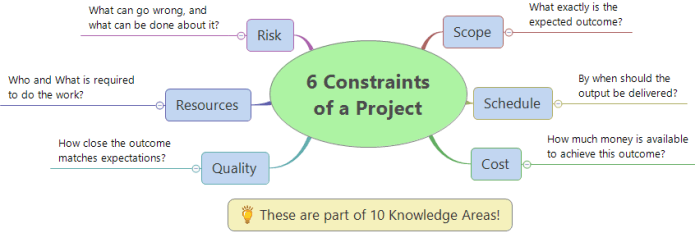 If you asked any seasoned project manager about the most challenging part of project management, most likely the answer would be “managing project constraints“. Or something close enough to that.
If you asked any seasoned project manager about the most challenging part of project management, most likely the answer would be “managing project constraints“. Or something close enough to that.
Major part of your project management effort goes into managing constraints.
Have you read about the six legged robot by NASA to make human outposts on Mars?
What do you think would happen even if one of these legs do not work as designed, or get stuck in the Martian terrain?
In simpler words, the robot would not function to the extent that it is supposed to. This will impact the Mars mission.
The 6 project constraints are similar to this 6 legged robot.
Each leg represents a constraint, and an issue with any of the constraints may impact the entire project –
 Figure 1: The 6 project constraints
Figure 1: The 6 project constraints
These constraints are interrelated, so a strain on one of the constraints will affect one or more of the other constraints. The image below shows classic triple constraint triangle.
Figure 2: Impact on any of Scope, Time (Schedule) and Cost may have an impact on Quality of deliverable
Imagine pinching any of the edges of this triangle. What would happen to the other two points? They get stretched. And the area of the triangle gets skewed.
The same thing happens when any of these 3 core constraints – scope, time (in other words, schedule) and cost, are strained. Each will influence the other two – and may result in poor quality of the product.
All of the 6 constraints influence each other in that any one getting affected impacts one or more of the rest.
Some examples of how constraints are related –
- If necessary resources are not available, time to deliver will increase. This may also increase project cost, because alternate resources if available, may be more expensive than planned.
- If QA team finds that quality of deliverable is going bad, more resources may be required. This increases the cost (additional resources) and effort to fix the faulty deliverable. This will also increase the time to deliver.
- If scope creep happens on the project, it will result in increased time, cost, resources and potentially reduced quality. And thus increased risk on delivery.
Managing 6 constraints is as much of an art as science. They will test the mettle of project manager. But do not worry, with the knowledge of PMBOK® processes and some support from your organization (PMO), managing these constraints should be a challenge that you enjoy.
In the next lesson we shall see who is a project manager, and how to become a good one!




